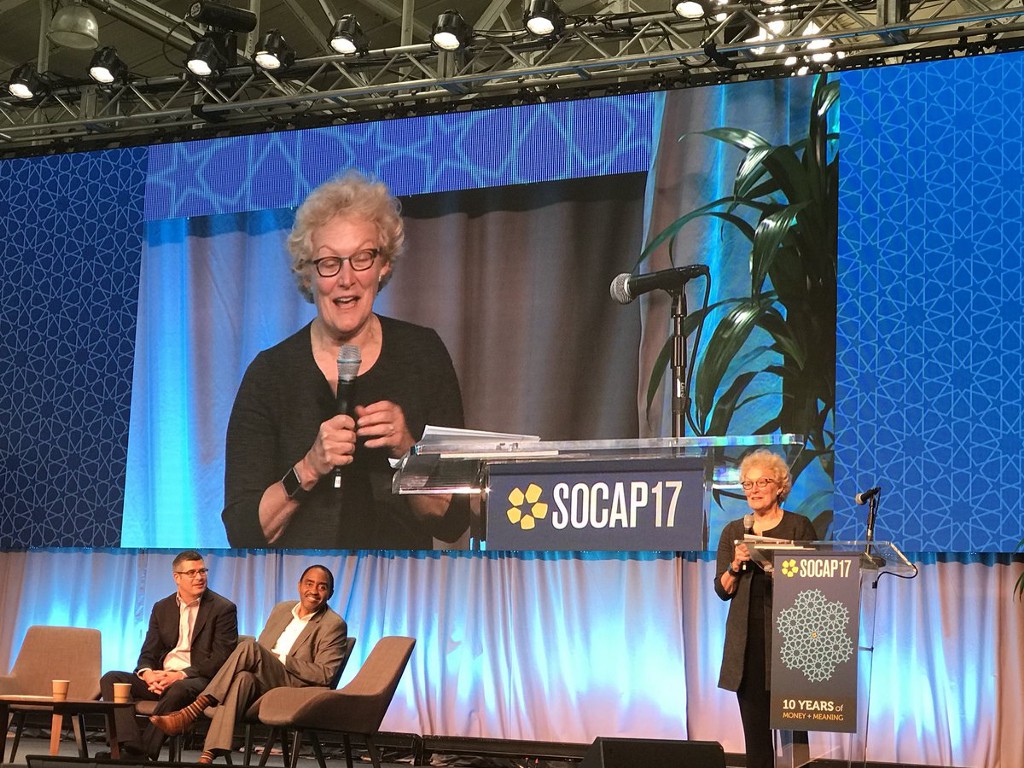At the SOCAP conference last month, Emmet Carson, president of the Silicon Valley Community Foundation, the nation’s largest, described their impressive $500 million-plus in impact investments as “not nearly enough.” I noted that the Heron Foundation views its arrival at 100% of assets invested for mission as a “false summit.”
In my remarks in San Francisco, on a panel on foundations’ leadership role in impact investing led by Matt Onek of Mission Investors Exchange, I asked “now what?” for fellow foundations and for Heron.
A small group of foundations have been early movers in small segments of the impact investing market. But we have a long way to go before we can claim victory, or even substantial progress. The problems we aspire to solve are, if anything, growing larger and more urgent daily. We need to up our game.
How are we doing?
I’m often asked, “What percentage of foundations are doing 100% impact investing?” I always answer, “all foundations are doing 100% impact investing…we just don’t know whether our investment portfolio companies’ impact is positive or negative.”
For most foundation boards of directors, the question of whether their “100%” is contributing to or undermining their philanthropic missions is still off the table.
https://medium.com/media/eb41009a46819b10cf3eade040db7b6e/href
Yet there is some progress.
- Some private foundations — including some very large ones — have increased allocations from their endowments for mission-focused investments, and are investigating the potential of “all-in” mission investing;
- Several private foundations contribute to the support of the infrastructure of impact investing , including SASB, Mission Investors Exchange, GIIN, B-Lab, CECP, ImpactAlpha (not to mention the long-time nurturing of the micro-finance and community development finance worlds over the past 40 years);
- Community foundations, in particular, are increasingly looking for creative ways to build human and social capital, nurture sources of “connective capital” in their communities, deploy donor-advised funds and more.
That said, we have a long way to go before our performance catches up with our rhetoric.
All organizations and people resist fundamental change. This is especially true of philanthropic institutions, whose endowment assets insulate them from external accountability. Foundations that do not affirmatively spend or invest all their philanthropic assets with mission in mind face some “deadly perils.” Luckily, for those moving forward, there are some “saving graces” as well.
Deadly Peril №1: Our outmoded business model encumbers our effectiveness.
The cherished conviction that investing and giving (money and mission) exist (and belong) in separate spheres is false. This is reinforced by the foundation business model, which is primarily an instrument of tax compliance expediency, not philanthropic effectiveness. It undermines our potential for real impact.
Clinging to an outmoded business model threatens us with irrelevance. In the words of W. Edwards Deming, “a bad system will beat a good person every time.” The many good people in the foundation world are cut off from opportunity by their system.
Let me explain. The business model of the private foundation separates, operationally, the process of investing 100% of the assets of the foundation (typically done conventionally for maximum return), from the process of spending a portion of those assets (typically around 5% by IRS rules) for “social good,” broadly construed.
This model embodies the faulty assumption that these two worlds are discrete, that the natural order of things requires that for-profit companies (investees of 100% of foundations’ capital) run rampant, free of any philanthropic boundaries. That essentially gives companies license to create the problems the “program side” is meant to solve with small grants. The foundation accepts that is the inalterable and natural order of things.
It’s possible that this institutional model was suited for a past age, perhaps to address the problems of a 19th century world where business was bound to place and intertwined global problems were largely absent. Today, we don’t have the luxury of sequential actions or delimited problems. We are in an era of systemic problems and compressed space and time. The separation of business, capital markets and investing from philanthropy, problem-solving and addressing market failures can’t succeed.
By accepting that this separation is optimal, foundations reinforce the convenient misconception that financial return and social benefits are somehow opposites, and that grant making and enterprise finance are similarly unrelated, better pursued in these separate worlds. From Heron’s point of view, this expedient undermines our effectiveness against many of the problems we are trying to solve. Foundations that embrace it imperil their missions.
Deadly Peril №2: We will lose our claim to the moral high ground.
Our rhetoric — words and phrases such as “urgency,” ”interconnection,” “systemic,” ”beneficiary voice,” ”the risk capital for society,” ”innovation engines” — is hollow if the bulk of our assets are invested in organizations that contribute to the problems we address with grants on the other side of the house. Are we fully recognizing beneficiary and mission risk in our asset deployment choices? If we are not, we are on a fool’s errand on the grant side.
I have yet to meet a program officer who thinks that the problems they are working on are disconnected from our economic system. We have a duty to challenge ourselves to be moral leaders not only among nonprofits but up and down the economy from which our profits, and grant dollars, come. We are philanthropic institutions, not everyday investment managers.
Deadly Peril №3: We will become increasingly irrelevant.
The philanthropic business model is already diversifying and changing: Omidyar, Skoll, Emerson Collective, and Chan Zuckerberg (to mention just a few) are hybrid models. Assets flowing to Donor-Advised Funds are on track for another record year. With these as peers, legacy and emerging conventional foundations must innovate to continue to be fit to purpose.
Given these “perils,” what are our opportunities, our “Saving Graces”? We know that all owners, investors and managers of capital have a stake in the state of the world, whether they define it as the market or their mission or their community.
Here is my short list of opportunities to escape the deadly perils, if we choose to take them.
Saving Grace №1: Seize our unique position for leadership.
We foundations have a unique position and vantage point from which to lead. We are both subject matter experts and investors. We are nonprofits, without the pull of commercial exigency. Shall we try to match performance to rhetoric? Or are we just talk?
We can, in Gandhi’s words, “be the change,” by unifying and reconciling the investment and mission function in our operations and among other market players.
Saving Grace №2: We can be actively influential inside and outside philanthropy.
We must engage with publics beyond our walls, where our nonprofit institutional status gives us standing to encourage others to connect their investing, their charitable activities, and their everyday lives.
Saving Grace №3: We can stand vigil for mission and impact at the intersection of money and mission.
The integrity of impact investment is under threat as the scale and numbers of those embracing the approach grows. We can be the umpire on that field, based on our own experience, and push progress with transparency and integrity, among all investor classes and all legal forms of organization.
This means a big push for accounting and metrics fit for the full range of enterprises and missions. Accounting is destiny — and here comes blockchain!
Big League: Transforming the capital markets with impact rigor and disclosure
We foundations have a choice. We can talk about our intentions. Or we can push our performance, live our rhetoric and lead by example.
We can stand for a world where there is either financial OR mission performance, or help create one where they must exist together, over time, to produce real positive results, both financial and social.
We can make a clear choice between a short-term, ideological risk management approach, OR take the less-conventional long view, a broad reckoning of risk and return which includes in the risk-calculus the people, causes and communities to which we are dedicated.
We can choose institutional self-indulgence — flights of fancy such as “measuring our success” (measuring success isn’t measuring), OR we can champion universal enterprise-level data standards and comparable reporting among organizations and market segments, including foundations.
It’s ours to lose. We can be comfortable but increasingly irrelevant. Or we can lead, and make a difference.
If we are to succeed, we will need to impart the real urgency that is pushing us today. We must “be the change” in our operations and actions. Philanthropy is a way of life, not an afterthought or a “nice to have,” but an imperative, built into our investments, our businesses and our daily lives.
Disclosure: The F.B. Heron Foundation supports ImpactAlpha’s editorial efforts.











